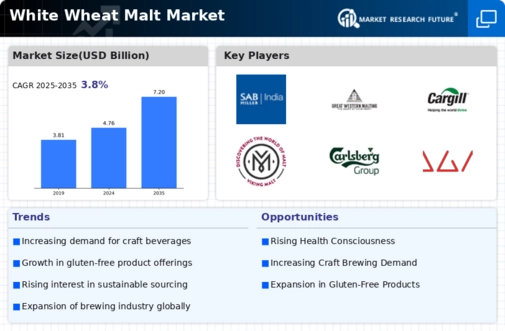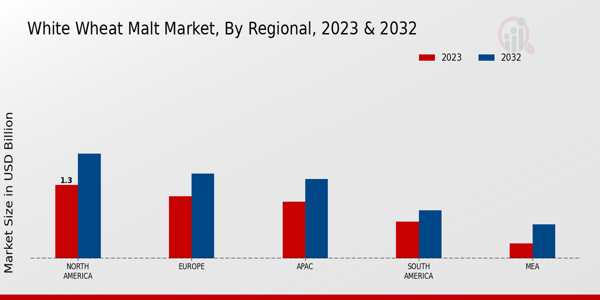Market Growth Projections
The Global White Wheat Malt Market Industry is poised for substantial growth, with projections indicating a market value of 4.76 USD Billion in 2024 and an anticipated increase to 7.2 USD Billion by 2035. This growth trajectory suggests a robust demand for white wheat malt, driven by various factors including the rise of craft beverages, health consciousness, and technological advancements in malting processes. The expected CAGR of 3.84% from 2025 to 2035 further underscores the market's potential, highlighting the importance of white wheat malt in the evolving food and beverage landscape.
Rising Demand for Craft Beverages
The Global White Wheat Malt Market Industry experiences a notable increase in demand for craft beverages, particularly in regions such as North America and Europe. This trend is driven by consumers' preference for unique flavors and artisanal products. Craft breweries are increasingly utilizing white wheat malt due to its ability to impart a smooth mouthfeel and enhance the overall flavor profile of beers. As a result, the market is projected to reach 4.76 USD Billion in 2024, reflecting a growing segment within the beverage industry. This shift towards craft beverages suggests a robust future for white wheat malt, as it becomes a staple ingredient in innovative brewing.
Regulatory Support for Whole Grains
Regulatory support for whole grains is a significant driver for the Global White Wheat Malt Market Industry. Governments worldwide are promoting the consumption of whole grains as part of healthy diets, leading to increased awareness and demand for products containing white wheat malt. Initiatives aimed at improving public health through dietary guidelines encourage food manufacturers to incorporate whole grains into their offerings. This regulatory environment creates opportunities for growth in the white wheat malt sector, as it aligns with consumer preferences for healthier, whole grain options.
Health Consciousness Among Consumers
The Global White Wheat Malt Market Industry is influenced by a rising health consciousness among consumers, who are increasingly seeking healthier food and beverage options. White wheat malt, known for its high nutritional value, is being incorporated into various products, including baked goods and cereals. This trend aligns with the growing demand for whole grains and natural ingredients. As consumers prioritize health and wellness, manufacturers are likely to innovate and create products that highlight the benefits of white wheat malt. This shift could contribute to the market's growth, as it positions white wheat malt as a desirable ingredient in health-oriented products.
Expansion of the Food and Beverage Sector
The Global White Wheat Malt Market Industry benefits from the ongoing expansion of the food and beverage sector, particularly in emerging markets. As urbanization increases and disposable incomes rise, there is a growing demand for diverse food products, including those made with white wheat malt. This ingredient is being utilized in various applications, from baked goods to snacks, catering to the evolving tastes of consumers. The market is projected to reach 7.2 USD Billion by 2035, indicating a strong potential for growth as manufacturers continue to explore the versatility of white wheat malt in new product development.
Technological Advancements in Malting Processes
Technological advancements in malting processes are significantly impacting the Global White Wheat Malt Market Industry. Innovations such as precision malting and improved drying techniques enhance the quality and efficiency of malt production. These advancements not only improve the flavor and aroma of the malt but also reduce production costs, making white wheat malt more accessible to manufacturers. As the industry embraces these technologies, it is expected that the market will grow at a CAGR of 3.84% from 2025 to 2035. This growth trajectory indicates a positive outlook for white wheat malt as a key ingredient in various applications.








